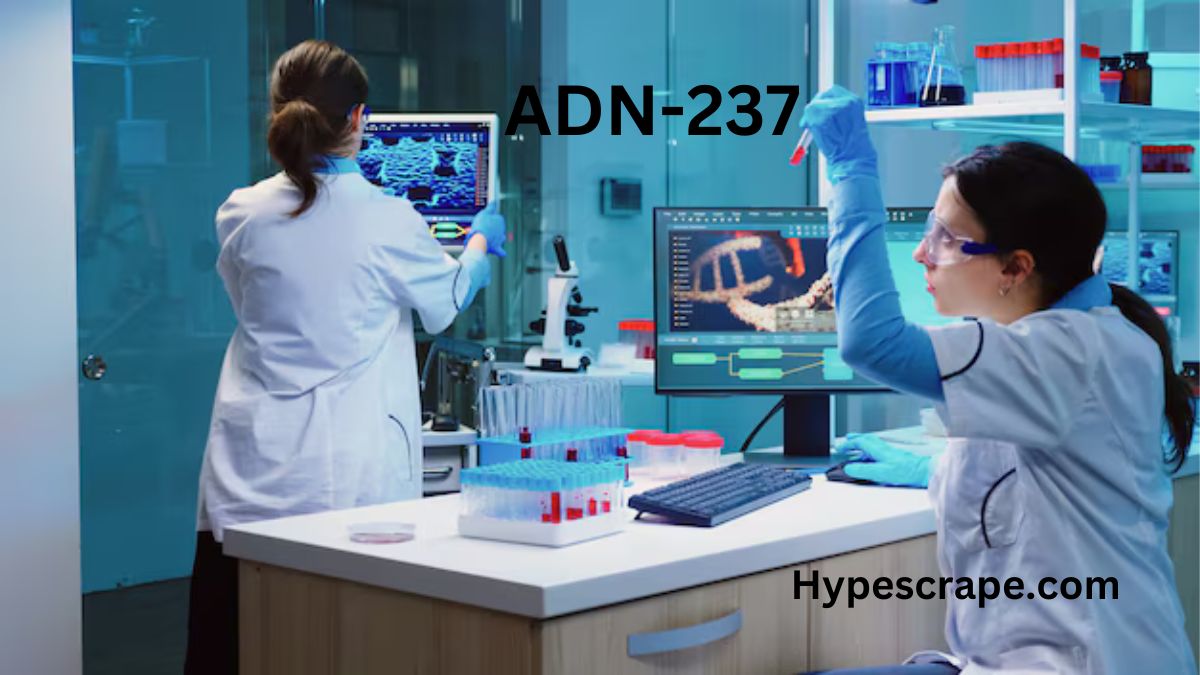HEALTHCARE
Revealing the Future of Medicine with ADN-237

In the rapidly evolving field of medicine, innovations are the key to overcoming some of the most pressing health challenges we face today. Among these breakthroughs is ADN-237, a name that has become synonymous with hope and potential in tackling various diseases. But what exactly is ADN-237, and why should you, someone interested in medical advancements, care about it?
This blog post dives deep into the world of ADN-237, exploring its origins, mechanisms, applications, and future prospects. Whether you’re a healthcare professional, a researcher, or someone keen on understanding the future of medical treatment, this comprehensive guide will provide the insights you need. Join us as we unfold everything there is to know about this groundbreaking compound.
The Genesis of ADN-237
Every innovation has a story. Understanding the origins of ADN-237 involves tracing back to the initial discoveries and scientific inquiries that led to its development. In the late 20th century, researchers embarked on a quest to find solutions for complex diseases that traditional medicines struggled to address. This pursuit led them to explore new frontiers in biotechnology and pharmacology.
ADN-237 emerged from these explorations as a potential game-changer. Its development was spearheaded by a consortium of scientists who leveraged cutting-edge technology and research methodologies. They aimed to create a compound that could interact with biological systems in novel ways, offering therapeutic benefits previously unattainable. This ambition laid the foundation for Adn-237, setting it on a path toward becoming a pivotal player in modern medicine.
The compound’s genesis was also marked by intensive collaboration across disciplines. Chemists, biologists, and medical practitioners worked hand-in-hand, pooling their expertise to refine its molecular structure and enhance its efficacy. Such interdisciplinary efforts underscore the collaborative nature of contemporary scientific endeavors, where breakthroughs are seldom the result of solitary genius but rather collective ingenuity.
Understanding the Mechanism of ADN-237
To appreciate the potential of ADN-237, it’s crucial to understand how it works. At its core, ADN-237 is designed to interact with specific cellular pathways, modulating biological processes that contribute to disease progression. The compound’s mechanism of action is rooted in its ability to bind to targeted receptors, influencing cellular behavior and promoting therapeutic outcomes.
Central to ADN-237’s efficacy is its specificity. Unlike traditional drugs that may affect multiple systems, leading to a broad range of side effects, ADN-237 is engineered to hone in on precise biological targets. This targeted approach not only enhances its therapeutic impact but also minimizes adverse reactions, making it a safer alternative for patients.
The intricacies of ADN-237’s mechanism are still being unraveled, with ongoing research shedding light on its nuances. Scientists are particularly interested in understanding how it crosses biological barriers and penetrates tissues, optimizing its delivery to affected areas. Such insights are crucial for refining its applications and maximizing its clinical potential.
Clinical Applications of ADN-237
The versatility of ADN-237 is reflected in its wide array of clinical applications. From chronic illnesses to acute conditions, this compound holds promise across a spectrum of medical scenarios. Its ability to modulate cellular processes makes it a candidate for treating diseases that have long eluded effective intervention.
One of the most notable applications of ADN-237 is in oncology. Cancer treatment has historically been fraught with challenges, primarily due to the complexity and heterogeneity of tumors. ADN-237 offers a ray of hope by targeting cancer cells with precision, disrupting their growth and spread while sparing healthy tissues. Clinical trials have demonstrated its potential in reducing tumor size and improving patient outcomes, garnering attention from oncologists worldwide.
Beyond oncology, ADN-237 is also being explored for its role in neurodegenerative diseases. Conditions like Alzheimer’s and Parkinson’s, characterized by progressive neuronal damage, pose significant treatment challenges. Preliminary studies suggest that ADN-237 may offer neuroprotective benefits, slowing disease progression and enhancing patient quality of life. These findings are paving the way for more extensive research into its neurotherapeutic applications.
Safety and Efficacy of ADN-237
The safety and efficacy of any medical treatment are paramount considerations, and ADN-237 is no exception. Robust clinical trials have been conducted to evaluate its therapeutic potential and assess its safety profile. The results thus far have been promising, indicating that ADN-237 is well-tolerated and effective across various patient populations.
A key aspect of ADN-237’s safety lies in its targeted action. By focusing on specific biological pathways, it reduces the risk of off-target effects, which are often responsible for adverse reactions in traditional therapies. Patients receiving ADN-237 have reported fewer side effects, suggesting that it may offer a more patient-friendly treatment option.
The compound’s efficacy has been demonstrated in multiple studies, with data supporting its use in both monotherapy and combination regimens. Its ability to enhance the effects of existing treatments further underscores its utility in clinical practice. Ongoing research continues to monitor its long-term effects, ensuring that it remains a safe and viable option for patients with diverse medical needs.
The Role of Research and Development
The story of ADN-237 is still being written, with research and development playing a central role in its evolution. Scientists across the globe are actively investigating its properties, seeking to unlock new therapeutic opportunities and refine its applications. These efforts are supported by significant investments in R&D, highlighting the medical community’s commitment to harnessing its full potential.
Collaborations between academic institutions and pharmaceutical companies have proven instrumental in advancing ADN-237’s development. Such partnerships facilitate the exchange of knowledge and resources, accelerating the pace of discovery and innovation. Researchers are also leveraging advanced technologies, such as AI and machine learning, to optimize its formulation and enhance its delivery mechanisms.
The R&D process is iterative, with each discovery building on previous insights. This dynamic cycle of inquiry and experimentation ensures that ADN-237 remains at the forefront of medical innovation, continually adapting to meet emerging challenges and opportunities in healthcare.
Challenges and Considerations
Despite its promising potential, the development and implementation of ADN-237 are not without challenges. Regulatory hurdles, logistical complexities, and ethical considerations are just a few of the obstacles that researchers and stakeholders must navigate as they work to bring this compound to market.
Regulatory approval is a critical step in the development of any new treatment, and ADN-237 is no exception. Ensuring compliance with stringent safety and efficacy standards requires meticulous documentation and robust clinical data. Navigating this process can be time-consuming and resource-intensive, necessitating strategic planning and collaboration between developers and regulatory bodies.
Logistical challenges also abound, particularly in the areas of production and distribution. Scaling up manufacturing processes to meet global demand requires significant infrastructure and expertise. Additionally, ensuring equitable access to ADN-237 across diverse populations is an ethical imperative that poses logistical challenges, particularly in low-resource settings.
The Future of ADN-237
Looking ahead, the future of ADN-237 appears promising, with exciting developments on the horizon. Ongoing research is expected to yield new insights into its mechanisms and applications, expanding its utility across a wider range of diseases and conditions.
One area of active exploration is the potential for personalized medicine. By tailoring ADN-237 treatments to individual patient profiles, healthcare providers can optimize therapeutic outcomes and enhance patient satisfaction. This approach aligns with broader trends in precision medicine, which seeks to deliver customized treatments based on genetic, environmental, and lifestyle factors.
The integration of ADN-237 into existing healthcare systems will also be a focal point in the coming years. Efforts to streamline its implementation and ensure seamless adoption in clinical practice are critical for maximizing its impact. This includes developing guidelines and best practices for its use, as well as fostering collaboration between healthcare providers, researchers, and industry stakeholders.
Real-World Impact of ADN-237
The real-world impact of ADN-237 extends beyond clinical settings, influencing various aspects of healthcare and society. By offering new treatment options and improving patient outcomes, it has the potential to alleviate the burden of disease on individuals, families, and communities.
For patients, ADN-237 represents hope and empowerment. Its ability to address unmet medical needs provides relief and improves quality of life, fostering a sense of agency and optimism. The ripple effects of these benefits extend to caregivers and support networks, easing the emotional and financial strains associated with chronic illness.
On a broader scale, ADN-237’s impact is felt in the realms of public health and healthcare systems. By reducing disease prevalence and improving treatment efficacy, it contributes to more sustainable and efficient healthcare delivery. This, in turn, alleviates pressure on healthcare resources and supports the overall well-being of populations.
Insights from Experts
Expert insights provide valuable perspectives on the implications and potential of ADN-237. Healthcare professionals, researchers, and industry leaders offer unique viewpoints that enrich our understanding of this compound’s place in modern medicine.
Oncologists have lauded ADN-237 for its innovative approach to cancer treatment, emphasizing its role in advancing precision oncology. By targeting specific molecular pathways, it offers new avenues for managing complex malignancies and improving patient prognosis.
Neurologists, too, are optimistic about ADN-237’s applications in neurodegenerative diseases. They highlight its neuroprotective properties and potential to slow disease progression, providing a much-needed alternative to current therapies.
Industry leaders emphasize the importance of continued research and collaboration in realizing ADN-237’s full potential. They underscore the need for strategic partnerships and investments to drive innovation and ensure that this groundbreaking compound reaches those who need it most.
The Path Forward
The path forward for ADN-237 is characterized by exploration and innovation. As researchers continue to unlock its potential, the possibilities for transforming patient care and advancing medical science are boundless.
Continued investment in research and development is essential for sustaining momentum and driving progress. Collaborative efforts between academia, industry, and healthcare providers will be crucial for translating scientific discoveries into tangible outcomes.
Patient engagement and feedback will also play a pivotal role in shaping the future of ADN-237. By listening to patient experiences and incorporating their insights into research and development, stakeholders can ensure that this compound remains patient-centric and responsive to evolving needs.
Conclusion
In summary, ADN-237 stands as a testament to the power of scientific innovation in transforming healthcare. Its development and applications reflect the ingenuity and dedication of researchers and stakeholders committed to advancing medical knowledge and improving patient outcomes.
As we look to the future, the potential of ADN-237 is both inspiring and promising. By continuing to explore its capabilities and address challenges, we can unlock new opportunities for improving health and well-being on a global scale.
For those interested in learning more about ADN-237 and staying informed about the latest developments, we invite you to explore additional resources and engage with the vibrant community of researchers, healthcare professionals, and industry leaders driving this groundbreaking field forward. Together, we can shape the future of medicine and empower individuals to lead healthier, more fulfilling lives.
HEALTHCARE
From Road Debris to UV Rays: What Threatens Your Car’s Shine?

Car surfaces are always at risk, which can compromise their durability and appearance. These risks include environmental factors that might damage the paint over time, such as UV radiation, bird droppings, tree sap, and acid rain. Chips, swirl marks, and scratches influence a car’s physical degeneration. Dirt and grime accumulation may cause the surface to lose its brilliance, requiring routine cleaning and maintenance to preserve its structural integrity and brightness.
One effective solution to protect a car’s surface is the application of ceramic coating. Ceramic coating for cars in Las Vegas, NV, offers a durable layer of protection that repels water, dirt, and contaminants, keeping the car’s paint in pristine condition. This protective coating prolongs the paint’s life and lessens the need for regular washings by improving the vehicle’s resilience to scratches and other environmental deterioration. Car owners may maintain the overall appearance of their vehicle while enjoying a high-gloss finish and simple maintenance with ceramic coating.
Understanding Environmental Pollutants
In addition to physical damage risks, cars constantly face an onslaught of environmental pollutants. Though seemingly innocuous, substances like industrial emissions, bird droppings, tree sap, and pollen can eat away at your vehicle’s paint, leading to dullness and eventual damage if not regularly cleaned. The key to managing pollutants is frequent washing and applying protective layers such as wax, which can be a barrier, preventing these contaminants from bonding with your car’s surface.
Impact of Road Debris
Road debris, from tiny stones to loose gravel, can cause serious harm to your vehicle’s paint, compromising its shine and finish over time. Combined with relentless UV rays, these elements accelerate wear, leading to fading, scratches, and a dull appearance. It’s no surprise that more car owners are now searching for automotive ceramic coating near me as they look for ways to defend their vehicle’s finish. A high-quality ceramic coating forms a strong, invisible barrier against harsh elements, helping preserve that showroom gloss while reducing the need for frequent maintenance.
UV Rays and Their Consequences
The blazing sun is not just a summer concern; year-round exposure to UV rays can wreak havoc on your vehicle’s paint. Prolonged sunlight exposure accelerates the oxidation process, where the paint gradually loses its vibrant color, leading to a dull, lifeless appearance. UV rays can also deteriorate the car’s interior, causing fading and cracking of upholstery and dashboards. Utilizing sun shades, parking in shaded areas, and applying UV-protective wax or coatings effectively preserve your car’s vibrance. Ignoring UV protection can result in costly restoration down the line, so it’s beneficial to incorporate these measures into your regular maintenance routine.
Acid Rain: A Silent Menace
Acid rain is real and may harm automobile exteriors, even though it seems like something from a dystopian novel. Rainwater’s acidic chemicals can etch into paint and clear coat, leaving behind ugly stains that are difficult to remove. These marks not only affect the beauty of your car but also weaken the paint’s ability to protect the vehicle from environmental influences. Frequent washes and protective coatings should be standard practice to combat this, especially if you live in an industrial area where acid rain is more prevalent. Regular waxing can act as a buffer, creating a slippery surface that repels pollutants and rain.
Protecting Your Car’s Finish
To keep your car looking its best, it’s essential to invest in quality protective measures. Options like high-quality waxes, sealants, and ceramic coatings offer varying degrees of protection, with ceramic coatings providing incredibly durable and long-lasting defense. These treatments help shield your vehicle from harmful UV rays, chemical etching, and other environmental factors. Applying ceramic coatings is akin to giving your car a shield, offering a robust line of defense against the many threats it faces daily.
Regular Maintenance Strategies
Maintenance is the silent guardian of your vehicle’s gloss and longevity. Routine checks and cleaning ensure contaminants do not get a foothold on your car’s surface. It’s advisable to adhere to a regular schedule for washes and employ microfiber cloths for drying to prevent scratches. A maintenance regime that includes periodic polishes and timely cleaning can preserve the appearance and enhance the vehicle’s value over time. The seemingly small details, like using the right cleaning products and techniques, make a huge difference.
HEALTHCARE
Pregnancy Sex Positions That Are Safe and Comfortable

Having sex when pregnant can be a lovely way to be intimate and connect with your spouse. However, as your body changes, so may your tastes and degree of comfort. The good news? Unless your healthcare practitioner advises you otherwise, having sex during a healthy pregnancy is usually safe. Continue reading to learn about the ideal postures for you and your partner as you navigate this exciting chapter.
Intimacy advice, safe and comfortable Pregnancy Sex Positions, and answers to frequently asked questions will all be covered in this guide.
Is It Safe to Have Sex During Pregnancy?
Yes, for the majority of couples. As long as your doctor hasn’t given you a medical warning against it, having sex during a healthy pregnancy is safe and even encouraged. Abstinence may be advised in cases of placenta previa, preterm labor symptoms, or unexplained vaginal bleeding.
Other advantages of pregnancy sex include reduced stress, improved sleep, and a closer emotional bond with your spouse. As your body changes, keep in mind to put comfort first and talk to your partner about what feels good—or doesn’t.
Best Sex Positions for Each Trimester
Something that feels good in the first trimester may feel uncomfortable in the third due to the distinct physical changes that occur during each trimester. Depending on the stage of pregnancy, these are some of the most comfortable and safest sex positions.
First Trimester
Because of the small size of your baby bulge during the first trimester, you can continue to wear positions that you are accustomed to. Most positions are comfortable at this point, provided you feel capable of handling any side effects, like as weariness or nausea.
- Missionary Position
When there isn’t a significant bump to worry about, this traditional position is ideal for the early stages of pregnancy. Try supporting yourself with a pillow beneath your hips if you start to feel uncomfortable.
- Spooning
Lying side by side allows for gentle, slow intimacy. It’s also a great option if you’re experiencing early pregnancy fatigue.
- Woman on Top
You have control over depth and motion when you’re on top, which makes it a flexible choice at any point throughout pregnancy.
Second Trimester
Exploring various postures is a fantastic idea during the “honeymoon trimester,” which is frequently associated with more energy and decreased nausea. However, some positions become less useful when your belly starts to protrude.
- Spooning (Side-Lying)
This position remains a favorite because it reduces any pressure on your abdomen. Plus, it allows for close, skin-to-skin intimacy.
- Reverse Cowgirl
Similar to “woman on top,” this variation lets you control movement while facing away from your partner. It also keeps weight off your belly.
- Edge of the Bed
Your spouse should stand or kneel in front of you as you lie back on the edge of a firm bed. This position accommodates your growing bulge while reducing back strain.
Third Trimester
Your bulge will probably take up most of your range of motion in the last few weeks of Pregnancy Sex Positions. Avoid anything that feels overly demanding and give priority to positions that take your weight off your abdomen.
- Side-by-Side (Facing Each Other)
Lying on your sides facing each other is intimate, belly-friendly, and manageable this late in pregnancy.
- Doggy Style
Kneeling on your hands and knees can help avoid any pressure on your stomach. Consider leaning forward onto pillows for extra support.
- Modified Sitting Positions
Sitting on your partner’s lap while leaning back against a chair or headboard can offer comfort and connection without putting strain on your belly.
Tips for Comfort and Intimacy
Navigating intimacy during pregnancy includes more than just finding comfortable sex positions. Here are some more pointers to help you and your companion have a good time.
- Use Pillows for Support
Support your bump or back with pillows in different positions. These can make a huge difference as your body adjusts.
- Choose Positions That Minimize Pressure
Avoid positions where your partner is putting direct weight on your abdomen. As your pregnancy progresses, positions that shift this pressure are especially important.
- Communicate Openly
Talking to your partner is crucial throughout pregnancy because it’s a period of both physical and emotional changes. To ensure understanding, discuss what feels good and what doesn’t.
- Use Lubrication
Pregnancy hormones may alter your body’s natural lubrication levels. Opt for a pregnancy-safe, water-based lubricant to increase comfort during sex.
- Take Your Time
Pregnancy is not the time for rushed intimacy. Slow down and enjoy both physical and emotional closeness.
Common Concerns About Pregnancy Sex
Pregnancy brings many questions and concerns about intimacy. Here are answers to some of the most common ones.
- Can Having Sex Harm the Baby?
No, the uterine muscles, the mucus plug that protects the cervix from infections, and the amniotic sac all provide excellent protection for the fetus.
- Can Orgasms Cause Preterm Labor?
Orgasms are usually innocuous, though they can result in minor uterine contractions. Consult your physician, though, if you are experiencing symptoms of preterm labor or a high-risk pregnancy.
- What If I Have No Libido?
Stress, exhaustion, and hormonal fluctuations can all impact your sex drive. This is quite typical. Put your attention on other ways to strengthen your relationship, such as sharing time or snuggling.
When to Consult Your Doctor
Although many couples find that having sex during pregnancy is safe, you should always see your doctor if you suffer from any of the following symptoms after having sex:
Cramping or pain
bleeding from the vagina
Strange discharge
Preterm labor symptoms
Your doctor is there to offer advice and make sure you and your unborn child are safe and healthy.
Maintaining Intimacy Beyond Sex
During pregnancy, there may be many physical and emotional ups and downs. If you’re not constantly in the mood for sex, don’t discount the benefits of connecting in other contexts, like:
Enjoying a quiet meal together
Giving each other massages
Walking or practicing yoga together
Simply touching hands or giving a hug
Small moments of connection can strengthen your relationship even if traditional intimacy is not an option.
Enjoy This Moment of Bonding
Pregnancy-related sex is an opportunity to strengthen your relationship and acknowledge the changes your body is undergoing. This period can be a happy part of your pregnancy experience if you experiment with comfortable sex positions, keep lines of communication open, and concentrate on what feels good for you both.
You should follow your gut and adjust to your comfort level because every pregnancy is different. Enjoy this private and thrilling phase of your relationship above all else.
HEALTHCARE
Thriving in Modern Healthcare: Strategies for Success

Understanding Modern Healthcare Needs
Today’s healthcare landscape is multifaceted and quickly evolving, demanding an approach that places patient-centered care at its core. This means healthcare systems must constantly innovate and adapt to meet the individual needs of their patients.
Technological advancements have transformed traditional care practices, driving providers towards an integrated approach that balances advanced tools with a personalized human touch. Equipped with cutting-edge technologies like AI-driven diagnostic tools and electronic health records, healthcare professionals can deliver more precise and effective treatments. However, it is crucial to maintain a balance, ensuring that technology enhances, not overshadows, the personal connection and trust essential in healthcare.
Building Strong Patient Relationships
Effective communication is pivotal in building strong relationships between healthcare providers and patients. Facilities, such as a skilled nursing home facility Missouri, exemplify these principles by tailoring their services to provide a comprehensive and empathetic care experience that enhances patient well-being. Genuine conversation, empathy, and active listening play a significant role in understanding a patient’s concerns, fears, and expectations. These practices lay the foundations for trust and confidence, essential for patient satisfaction and adherence to treatment plans. By employing personalized care strategies, providers acknowledge each patient’s unique journey, preferences, and cultural backgrounds, thus ensuring they receive practical and respectful care.
A personalized approach does more than treat the ailment; it considers the patient’s lifestyle, tasking healthcare professionals with becoming advocates for holistic health. By integrating wellness education and preventative care strategies, patients are empowered with the knowledge and support required to manage their health actively.
Embracing Technology in Healthcare
With the rise of technology, healthcare is entering an era where digital tools significantly augment patient care. Innovative tools such as wearable health monitors, smart medical devices, and telemedicine platforms are integral to patient management strategies. These advancements grant patients greater access to healthcare services, especially in remote or underserved regions, while offering providers critical insights into patient health trends and data.
Telemedicine has seen a tremendous uptake post-pandemic, as it facilitates remote consultations, ensuring continuity of care even when in-person visits aren’t possible. This shift towards digital health not only cuts down travel and waiting times for patients, enhancing convenience, but also expands the reach of healthcare providers, allowing them to cater to a broader demographic effectively.
Navigating Healthcare Regulations
Compliance with healthcare regulations is non-negotiable and critical for any healthcare operation—regulatory bodies set forth quality and safety standards to protect patients and ensure ethical practices within healthcare settings. Keeping abreast of policy changes and updates is imperative for operational and clinical staff. Regular training workshops and a culture that values compliance can significantly mitigate risks associated with non-compliance, protecting both the facility and its patients.
Staying informed is not merely about avoiding penalties; it is about committing to high standards of patient care. Professional development and continued education in regulatory affairs empower healthcare leaders to drive compliance efforts that meet and exceed expected legal standards.
Fostering Collaborative Environments
The complexity of modern healthcare requires a robust team-based care model. Collaborative practices tap into the varied expertise of interdisciplinary teams, bringing together diverse skill sets that collectively enhance patient care outcomes. Teams that embrace open communication shared decision-making, and a collective vision of quality care can address patient issues more comprehensively.
Effective collaborations break down silos and promote a culture of inclusion and support, where professionals work not in parallel but in partnership. Regular team meetings, clearly defined roles, and mutual respect ensure interdisciplinary collaborations are successful and productive, ultimately delivering a more cohesive and efficient patient care experience.
Enhancing Healthcare Education and Training
Continuous education and advanced training are vital to maintaining a competitive edge in the healthcare industry. With medical science and technology advancing at breakneck speeds, healthcare providers must constantly update their skills and knowledge. Engaging in structured educational programs, attending workshops, and pursuing certifications help professionals stay informed about the latest advancements and best practices.
Mentorship and practical experience also play crucial roles in building a competent healthcare workforce. Seasoned professionals can provide invaluable insights and guidance, helping novices navigate the challenging landscape of healthcare service delivery. Experiential learning opportunities allow healthcare practitioners to apply theoretical knowledge in real-world settings, fostering a deep understanding and proficiency in their field.
Data and Analytics in Healthcare
In the age of digital transformation, data in healthcare is a game-changer. Leveraging big data analytics, healthcare providers can glean critical insights from patient data, transforming how they deliver care. Data analytics enable hospitals and clinics to identify trends, predict health outcomes, and tailor treatments, thereby enhancing the quality of care while reducing costs.
Utilizing data also fosters a proactive approach to healthcare. Predictive analytics can foresee potential health risks, enabling preventative measures and early interventions. This shift from reactive to proactive care improves patient outcomes and optimizes resource allocation, ensuring that healthcare facilities can deliver efficient and personalized services to their communities.
Conclusion: The Future of Healthcare
The future of healthcare is bound by its capacity to adapt and innovate continuously. As technological, educational, and collaborative practices evolve, healthcare organizations must adapt to these new challenges and opportunities. The insights from current healthcare trends suggest a promising horizon filled with expanded capabilities and enhanced care delivery methods.
Facilities investing in technology, patient relationships, and ongoing education pave the way for a healthier, more efficient future care environment. As these elements synergize, the healthcare sector stands prepared not only to meet current demands but to anticipate and adapt to the ever-changing needs of the future.
-

 BLOG1 year ago
BLOG1 year agoEscape to Tranquility Experience Grange Bardage Percheronne in Normandy
-

 LIFESTYLE1 year ago
LIFESTYLE1 year agoAir Jordan 1 Retro High Off-White University Blue
-

 SOCIAL MEDIA1 year ago
SOCIAL MEDIA1 year agoDecoding the Drive Social Media Pyramid Scheme Mystery
-

 LIFESTYLE1 year ago
LIFESTYLE1 year agoAir Jordan 4 Retro Metallic Purple
-

 BLOG7 months ago
BLOG7 months agoDecoding 540-315-8592: From Numbers to Messages
-

 HOW-TO GUIDES1 year ago
HOW-TO GUIDES1 year agoShop Smart and Save with Goldengatemax.shop Online Guide
-

 BUSINESS1 year ago
BUSINESS1 year agoDemystifying 315-442-5267 Common Myths and Facts Revealed
-

 LIFESTYLE1 year ago
LIFESTYLE1 year agoAir Force 1 Shadow Pistachio Frost
